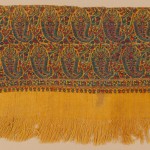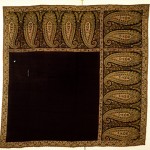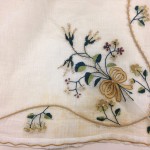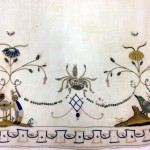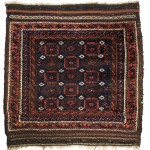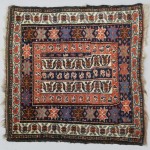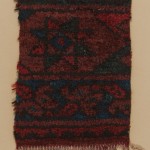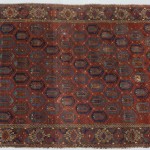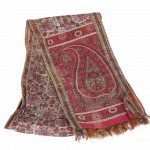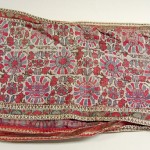“It is that Third Space, though unrepresentable in itself, which constitutes the discursive conditions of enunciation that ensure that the meaning and symbols of culture have no primordial unity or fixity; that even the same signs can be appropriated, translated, rehistoricized, and read anew.” — Homi K. Bhabha [1]
Historian C.A. Bayly has described the long nineteenth century as one of rapidly developing connections between distant human societies, which simultaneously created hybrid polities, complex forms of global economic activity, and a heightened sense of difference between people.[2] In The Birth of the Modern World, 1780-1914, Bayly focuses particularly on “global uniformities,” tracing the rise of similar forms of state, religion, political ideologies, and economic life in the nineteenth century. He argues that this process of global integration transformed artistic traditions in Europe, Africa, Asia, and Polynesia. Non-European arts borrowed and appropriated European ideas and techniques, while design motifs and styles from around the world made their way into European painting, sculpture, and decorative arts.
At the same time, the nineteenth century witnessed the rise of decorative arts produced for mass markets. The notion of interconnectedness therefore provides us with a useful starting point to examine the historical context of nineteenth century visual and material culture in the Five College collections. This exhibition situates the objects and collections of the Five Colleges within a connected history of global integration. Many of the objects included in the exhibition occupy an ambiguous space between East and West, which encourages us to ask: what cultural, political, and economic contexts created the space for objects like this to be produced, circulated, and collected?
The historical processes of capitalism and globalization form the foundation of Bayly’s analysis of how art changed in the nineteenth century. By 1914, elite and popular art became commodified, and new locations of art emerged in the museum and the market. In his discussion of how globalization transformed the production of decorative arts in China, for example, Bayly finds that pottery once made for the imperial house were now made for the market. Hybrid objects, “part European, part Chinese” now moved along trade routes to the living rooms of the rising international middle class in Europe (and the U.S.).[3] Textiles, and particularly Indian shawls, followed suit. The rise of factory production resulted in the rapid elimination of artisan textile industries in South Asia and the Middle East, while British textile-makers worked to use and adapt the styles and symbols of Indian producers. The Indian shawl, which once meant a sign of the wearer’s royal status and aristocratic merit, became a model for 1830s Scottish industrialists seeking to mass-produce Indian styles to sell on a global market.[4]
Mead Art Museum
AC T.1929.13
Historic Deerfield
HD 1989.74
A fragment in the Mead Art Museum’s collection, believed to be of Indian or Persian origin, functions in this exhibition as representative of an early nineteenth-century Indian shawl.[5] The fragment, along with many other objects, was acquired by Amherst College in 1929 as a gift from conservationist, collector, and philanthropist George Dupont Pratt (Amherst College Class of 1893). Pratt’s massive collection of pottery and textiles is illustrated by the number of objects donated to Amherst College in his name.[6] The shawl fragment in question features a repeating boteh motif composed of several colors: blue, green, red, and yellow. The boteh, or stylized leaf, motif is commonly referred to as paisley, named after Paisley, a town near Glasgow in Scotland, which became well-known for textile production. This motif also appears in a polychrome block printed shawl at Historic Deerfield. This nineteenth-century shawl is believed to be of French origin, but there is some uncertainty in this attribution.[7] In the nineteenth century, shawls became a ubiquitous accessory in women’s dress as they rapidly developed as an export item and Europeans began weaving their own shawls in imitation of Indian-produced examples.
While Bayly’s discussion of nineteenth-century art is centered on globalization and capitalism, art historian Natasha Eaton looks to empire and colonialism as the driving forces of transformation in material and visual culture. In Mimesis across Empires: Artworks and Networks in India, 1765-1860, Eaton examines the transactions that took place between the British metropole and colonial India. She focuses particularly on the junctures where Indian and British artistic practices came together to produce “weird pictures that foreground difference, repetition, and hybrid similitude.”[8] Eaton explores the production and circulation of courtly art at the conjunction of colonial and imperial encounters, but her discussion of these encounters provides an important corrective to what Bayly’s analysis lacks: a focus on the imperial, colonial contexts that facilitated global integration.
Bayly’s story of globalization prioritizes the exchange of ideas and objects along global networks. In contrast, Eaton critiques the use of “exchange” as an art historical methodology. Instead, she focuses on how the colonial situation in India produced and circulated hybrid artworks. Eaton adapts this notion of artistic hybridity from that of Homi K. Bhabha, who developed a theory of cultural hybridity in an effort to displace the legitimating narratives of cultural domination. In this case, the hybrid object is “neither one nor the other.” The hybrid object is produced and circulated in a “Third Space,” which exists on the boundaries in-between forms of difference and in the intersections of power. For Eaton, nineteenth-century Mughal art was produced within this colonial context.
Historic Deerfield
HD T.093
Historic Deerfield
HD 97.035
The hybrid object is a potentially useful way to understand some of the objects in the Five College collections. In particular, there are two textile fragments at Historic Deerfield with unclear origins.[9] According to staff at the museum, they might have been produced in France or India. The ambiguous origin of these fragments suggest that they were produced during a period of time when global material culture underwent a process of similitude, and the textiles might be considered neither French nor Indian, but hybrid. Regardless of their origin, the fragments were collected by women in New England, likely from dealers, whose acquisition of the objects were facilitated by increased global integration.
Mount Holyoke College Art Museum
MH 1997.14.145.1
Mead Art Museum
AC 1951.179
Eaton’s focus on power and the colonial context provides another means to analyze how some objects came to be here in Western Massachusetts. The large number of nineteenth-century textiles in the collections at the Five College Museums can be attributed to the expansion of a global market for decorative arts during the nineteenth and twentieth centuries, in which new locations for art emerged in the museum and the market. Wealthy alumni from Amherst, Mount Holyoke, and Smith Colleges (and their families) collected fine pieces of decorative arts. Their gifts and bequests form the bulk of the collections at these institutions. Items such as two khorjin (bag faces), one donated by the estate of Miss Isabel J. Turner (sister of James Turner, Amherst College Class of 1880) to the Mead Art Museum in 1951 and another donated to the Mount Holyoke Art Museum as a bequest of Eileen Paradis Barber in 1997, are examples of this collecting history.[10] Both were produced in rural regions at the borders between Iran and Azerbaijan (in the case of Turner’s khorjin) and Iran and Pakistan (in the case of Barber’s contribution).
Mead Art Museum
AC T.1929.14
Mead Art Museum
AC HTR.1936.24
Similarly, Turkmen rugs have made their way into the Mead Art Museum’s collections as gifts from notable alumni, William R. Mead (Amherst College Class of 1967) and George Pratt. Further research of this provenance might reveal with greater specificity how the donors acquired their collections, but they most likely purchased their textiles from art dealers who were actively participating in this extensive trade network.[11]
Other objects, such as silk scarves from India, are connected to nineteenth-century Christian missions. In 1859, Reverend Isaac Newton Hurd donated an Indian scarf to Mount Holyoke. He had spent over seven years as a missionary in Arcot and Chintadrepettah, India, prior to marrying Mount Holyoke Seminary alumna Rachel Loretta Cowles (Class of 1859) in 1860. There is little evidence surrounding the context in which Rev. Hurd donated the scarf, but it seems likely that he purchased the scarf while in India, and upon return to the United States, he gave it to Mount Holyoke Seminary.
Rev. Hurd served about three years on the North Alcot Mission of the Reformed Protestant Dutch Church of America, and for four years on the Madras Mission of the American Board in Chintadrepettah. Protestant missions in British India began in the eighteenth century and expanded over the course of the nineteenth and early twentieth centuries. These missions were intended to spread Christianity among the indigenous population, through preaching, translating texts into local languages such as Tamil, and establishing schools for converted Christian children.[12] The intertwined legacies of Christian missions and imperialism have been well documented in scholarship, suggesting that Christian missionary activity was central to the work of empire, in its British and American forms.[13]
The complex and hidden histories of how many objects came to be in the Five College collections can thus be viewed within the nexus of globalization, empire, colonialism, and modern capitalism. These large-scale historical processes produced the global integration that allowed these objects to travel as they did to Western Massachusetts. These objects have complex stories that surround their creation and their function as both decorative objects and as cultural capital. While we are fortunate to study these objects, it is imperative that we critically examine the circumstances that brought them to our museums. Indeed, as academic institutions we have an obligation to reveal the power structures and geographic webs that brought them to our museums, because these webs are integral to the provenience of the object.
[1] Homi K. Bhabha, The Location of Culture. New York: Routledge, 1994, p. 37.
[2] C.A. Bayly, The Birth of the Modern World, 1780-1914: Global Connections and Comparisons. Oxford: Blackwell Publishing, 2004.
[3] Bayly 2004, p. 371.
[4] Bayly 2004, p. 372.
[5] Accession Number: AC T.1929.13.
[6] A search query of “George D. Pratt” yields 300 object records on the Five Colleges and Historic Deerfield Museum Consortium Collections Database.
[7] Accession Number: HD 89.074; This shawl is listed on the database as “possibly” French.
[8] Natasha Eaton, Mimesis across Empires: Artworks and Networks in India, 1765-1860. Durham: Duke University Press, 2013.
[9] Accession Numbers: HD 97.035 and HD T.093.
[10] Accession Numbers: AC 1951.179 and MH 1997.14.145.1.
[11] Accession Numbers: AC HTR 1936.24 and AC T.1929.14.
[12] Proceedings of the South India Missionary Conference, held at Ootacamund. Madras: D.P.L.C. Connor, 1858, pp. 27-30.
[13] Francis Jennings, The Invasion of America: Indians, Colonialism, and the Cant of Conquest. Chapel Hill: University of North Carolina Press, 1975; Jean Comaroff and John Comaroff, Of Revelation and Revolution: Christianity, Colonialism, and Consciousness in South Africa. Chicago: University of Chicago Press, 1991; Arun W. Jones, Christian Missions in the American Empire: Episcopalians in Northern Luzon, the Philippines, 1902-1946. Bern: Peter Land Publishing, Inc., 2003.
